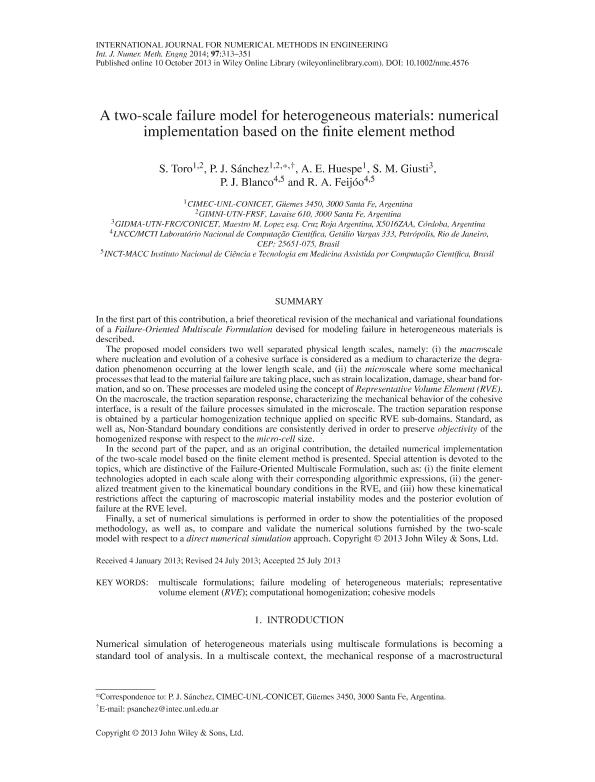Artículo
A two-scale failure model for heterogeneous materials: Numerical implementation based on the finite element method
Toro, Sebastian ; Sánchez, Pablo Javier
; Sánchez, Pablo Javier ; Huespe, Alfredo Edmundo
; Huespe, Alfredo Edmundo ; Giusti, Sebastian Miguel
; Giusti, Sebastian Miguel ; Blanco, Pablo Antonio; Feijóo, Raúl Antonino
; Blanco, Pablo Antonio; Feijóo, Raúl Antonino
 ; Sánchez, Pablo Javier
; Sánchez, Pablo Javier ; Huespe, Alfredo Edmundo
; Huespe, Alfredo Edmundo ; Giusti, Sebastian Miguel
; Giusti, Sebastian Miguel ; Blanco, Pablo Antonio; Feijóo, Raúl Antonino
; Blanco, Pablo Antonio; Feijóo, Raúl Antonino
Fecha de publicación:
02/2014
Editorial:
John Wiley & Sons Ltd
Revista:
International Journal for Numerical Methods in Engineering
ISSN:
0029-5981
Idioma:
Inglés
Tipo de recurso:
Artículo publicado
Resumen
In the first part of this contribution, a brief theoretical revision of the mechanical and variational foundations of a Failure-Oriented Multiscale Formulation devised for modeling failure in heterogeneous materials is described. The proposed model considers two well separated physical length scales, namely: (i) the macroscale where nucleation and evolution of a cohesive surface is considered as a medium to characterize the degradation phenomenon occurring at the lower length scale, and (ii) the microscale where some mechanical processes that lead to the material failure are taking place, such as strain localization, damage, shear band formation, and so on. These processes are modeled using the concept of Representative Volume Element (RVE). On the macroscale, the traction separation response, characterizing the mechanical behavior of the cohesive interface, is a result of the failure processes simulated in the microscale. The traction separation response is obtained by a particular homogenization technique applied on specific RVE sub-domains. Standard, as well as, Non-Standard boundary conditions are consistently derived in order to preserve objectivity of the homogenized response with respect to the micro-cell size. In the second part of the paper, and as an original contribution, the detailed numerical implementation of the two-scale model based on the finite element method is presented. Special attention is devoted to the topics, which are distinctive of the Failure-Oriented Multiscale Formulation, such as: (i) the finite element technologies adopted in each scale along with their corresponding algorithmic expressions, (ii) the generalized treatment given to the kinematical boundary conditions in the RVE, and (iii) how these kinematical restrictions affect the capturing of macroscopic material instability modes and the posterior evolution of failure at the RVE level. Finally, a set of numerical simulations is performed in order to show the potentialities of the proposed methodology, as well as, to compare and validate the numerical solutions furnished by the two-scale model with respect to a direct numerical simulation approach.
Archivos asociados
Licencia
Identificadores
Colecciones
Articulos(CCT - CORDOBA)
Articulos de CTRO.CIENTIFICO TECNOL.CONICET - CORDOBA
Articulos de CTRO.CIENTIFICO TECNOL.CONICET - CORDOBA
Articulos(CIMEC)
Articulos de CENTRO DE INVESTIGACION DE METODOS COMPUTACIONALES
Articulos de CENTRO DE INVESTIGACION DE METODOS COMPUTACIONALES
Citación
Toro, Sebastian; Sánchez, Pablo Javier; Huespe, Alfredo Edmundo; Giusti, Sebastian Miguel; Blanco, Pablo Antonio; et al.; A two-scale failure model for heterogeneous materials: Numerical implementation based on the finite element method; John Wiley & Sons Ltd; International Journal for Numerical Methods in Engineering; 97; 5; 2-2014; 313-351
Compartir
Altmétricas



